Weathering Extreme Weather
It’s no surprise that the global weather forecasting industry was valued at $2.1 billion in 2023. Extreme weather makes great headlines, drawing attention from the concerned and amazed alike.
Preparing for the most recent Sustainable Planet episode Weathering Insurance Premiums immediately sent me looking at the various extreme weather events wreaking havoc on homeowners, particularly in high-risk zones. In 2023, the U.S. recorded 28 billion-dollar disasters, up from the previous record in 2020. The E.U. is breaking similar records, racking up damages exceeding 5€ billion three consecutive years running, from 2021-2023, just from thunderstorms.
The Industrial Revolution not only changed economic, but ecological history. Steam engines needed coal to mass manufacture goods. Between July 2023 and June 2024, for the first time since the start of the Anthropocene Era, scientists recorded 12 consecutive months of temperatures 2.7 degrees Fahrenheit/ 1.5 degrees Celsius higher than their average before the fossil fuel era began. Rising global air and water temperatures are altering weather conditions and patterns. Blizzards dumping piles of snow or memorable floods were anomalous; now they are the norm. Hotter summer temperatures that start earlier and run later combine with warmer winter temperatures to affect ocean temperatures, insect populations, migration patterns, and growing seasons.
Precipitation
Hurricane Beryl hit Jamaica on July 3, 2024 in the Atlantic Ocean and left a trail of destruction along Mexico’s Yucatan Peninsula and thousands without power in Texas. To date, Beryl is the most powerful hurricane to hit the Atlantic this early in hurricane season, at one point reaching rare Category 5 strength. Yet scientists were unsurprised by this hurricane, aware that June’s record high ocean temperatures could fuel such a powerful storm. More heat causes bigger storms, ergo more heat earlier in the year increases the likelihood of bigger hurricanes earlier in the season.
Differing in name only by where they are prevalent, Hurricane Beryl, Tropical Cyclone Hidaya, and Typhoon Ewiniar are the same weather phenomenon. Bringing strong winds and heavy rainfall, this type of storm can be tracked for weeks in advance, covering large swaths of ocean. They can also hang over an area for days or weeks, giving them longer to batter whatever island or coastline they choose.
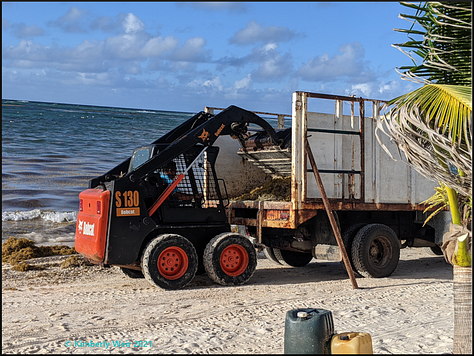

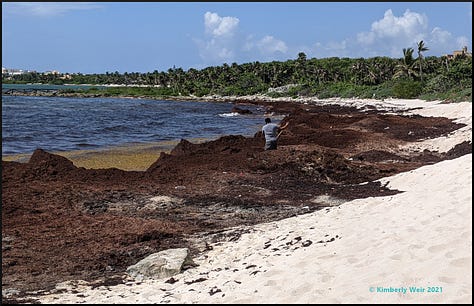
Also referred to as severe convection storms (SCS), thunderstorms differ from hurricanes. Caused by localized cells, these storms can cause strong winds, drop buckets of rain, produce hail, cause flash flooding, and are more likely to produce lightning than hurricanes. The summer of 2023 was particularly rough for Italy and France, which suffered annual losses 10 times worse than any year in a decade. Meanwhile, ‘Hail Alley’ took a battering in 2023. East of the US and Canadian Rocky Mountains, the band encompasses states and provinces from Texas to Saskatchewan. Damage from ‘large hail’ reached a two-decade high and caused $7 to $10 billion in damage over just five days in the Dallas-Fort Worth area.
Forecasters love the term bomb cyclone, the ‘weather porn’ term for storm systems that rapidly drop in a short period of time, rather unexpectedly ‘bombing’ the planet with snow or rain. Common along coastlines, bomb cyclones are spreading wider with climate change. Though forecasters also like to drop ‘polar vortex’ into reports announcing short-term extreme icy temperatures, like monsoons, this dip of Arctic air into the lower latitudes is quite normal. Scientists are now considering, however, whether the polar vortex reach is affected by climate change (particularly due to a short time-frame to track data trends). What experts do agree on is that climate change induces warmer winters and fewer cold temperature extremes.
Snow: My Favorite Frozen Precipitation
Every year on February 8, my only birthday wish is for snow. Unfortunately for me, snow is becoming less frequent in Cincinnati. This past year, it was a disappointing 59 degrees. Despite decreases in the frequency of snow and amount of precipitation, there is an increase in extreme snowstorms, such as 14.6” of snow falling in 6 hours on March 7, 2024 in North Platte, Nebraska.
‘Snow deluge’ was coined by a group of researchers to describe the piles of snow that fell in California in 2023, anomalous during a trend of ‘snow droughts’. Though the state depends on snow to replenish its water supplies, their study predicts a 58-percent drop in ‘extreme snow’ accumulation in the Sierra Nevada mountains, with a corresponding 73% decrease in total yearly snowfall. Due to rising temperatures, the precipitation still falls, but in the form of rain. The lack of ‘snowpack’, however, is problematic. The economic and environmental implications are astounding, from resort closings to wildlife displacement. Furthermore, this study found that rain replacing snow in higher elevations increases rainfall extremes, intensifying flooding, landslides, and soil erosion.
Tsunamis & Tornados
If hurricanes are scary, tsunamis are downright terrifying. Displaced water caused by seismic activity causes a succession of huge waves that can happen with very little warning and affect an entire ocean basin. One of the deadliest occurred on December 26, 2004. An Indian Ocean tsunami caused by an earthquake originating in Indonesia devasted coastal areas in India, Sri Lanka, and Thailand. Tsunami waves reached as far as Somalia, where an estimated 110 people were killed. Though not directly attributed to climate change, rising sea levels, coastal erosion, and landslides exacerbate the conditions that can cause tsunamis.
Thunderstorms and the wake of hurricanes can cause tornadoes and heavy rain, as Beryl just did across the U.S. Like tsunamis, tornados are indirectly linked to climate change as increased temperatures cause more severe storms. The U.S. had an above-average tornado count for 2023, with two tornadoes touching down in Iowa for the first time in the month of January since an anomalous occurrence in 1967. When I moved to Cincinnati, I had no idea tornados were a threat in the area. For the first several years, I wondered what the sirens were that I noticed from time to time around noon. Now I know, as the tornado siren sounds more frequently—and not just on the first Wednesday of every month at noon.
Heat Waves, Drought, & Wildfires
According to the National Oceanic and Atmospheric Administration (NOAA), the drought and heat wave that baked the southern and midwestern parts of the U.S. was the costliest weather-related event in 2023. Broiling temperatures hit all-time day and month highs in Texas, Arizona, Illinois, and California. Resulting damage totaled $14.5 billion, destroying crops and causing saltwater to backwash into the Mississippi River disrupting drinking water supplies in Louisiana.
Not surprisingly, extreme heat causes drought, which leads to wildfires—all of which lead to flooding, air pollution, desertification, and loss of habitat. Across the border, Canada was ravaged by wildfires, causing 6,132 fires that destroyed an area exceeding the size of the entire country of Greece. Wildfires, in turn, exacerbate climate change not only by destroying trees that process carbon dioxide, but stored carbon is released back into the atmosphere along with carbon monoxide and nitrogen dioxide particulates.
Maybe wind and dust storms are less Weather Channel worthy because they lack the monikers designated to other storms. Following changes in air pressure systems, strong winds move particulates through the air. Not to be confused with sandstorms, dust storms (also called haboobs) move fine dust particles and debris. They happen globally and are getting worse due to heat waves. Drought, desertification, and various agriculture methods increase dry soil particulates picked up in dust storms, which go into water systems, alter precipitation patterns, and feed ocean algae blooms and mountain lakes.
Flooding
Notably, any of the above weather phenomena can result in flooding. Excess snowfall outside of mountains melts directly into rivers rather than being stored at higher elevations for more gradual release. Flooding levels are breaking records worldwide, due to unprecedented amounts of rain falling in very short windows. On March 11, 2024, Sumatra was deluged by 11 inches in 6 hours—and it rained even heavier a month later in Indonesia!
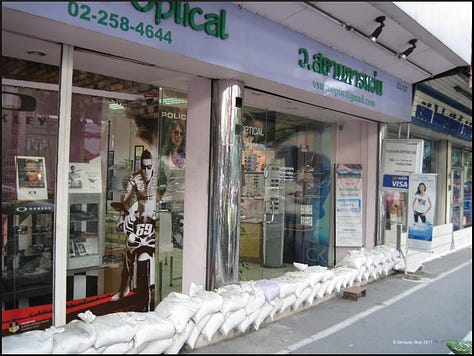
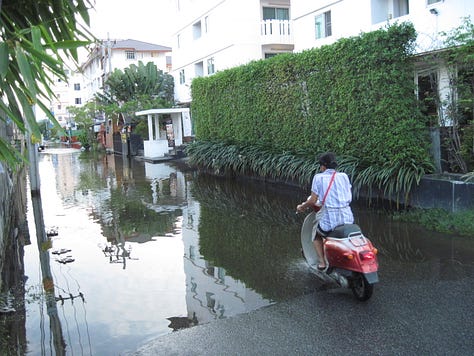
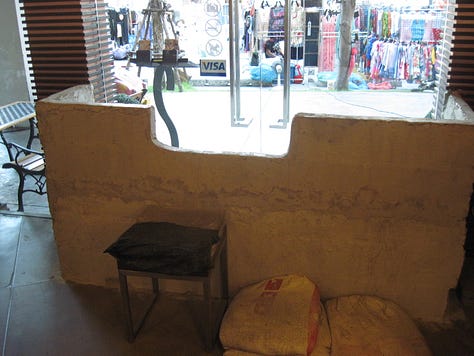
Up there in terms of scary weather events is landslides, which can be caused by flooding or seismic activity (including explosions used in mining). Monsoons are a naturally occurring weather event, quite important to replenishing water supplies in countries in Asia and Africa. But an early onset of the monsoon season in 2023 caused a series of floods in Pakistan that also triggered landslides. Just this week, at least 15 people died in Nepal as a result of flooding and landslides. And Nepal is not alone: Already this year countries as far and wide as Bangladesh, Kyrgyzstan, Bolivia, and the Philippines have faced similar destructive conditions.
Having covered a lot of ground, I’ll save my analysis of extreme weather for next week. As I mentioned, I was prompted to explore this topic due to weather-related insurance claims. Some years ago I read about the ‘invention’ of insurance in a fun and informative book Fifty Inventions that Shaped the Modern Economy, by Tim Harford. If you don’t want to splurge on the $5.94 used copy of this worthwhile read, I found this brief, yet informative history if you’re interested.






